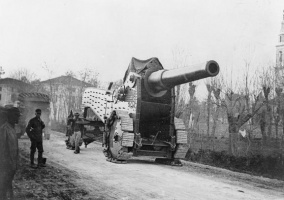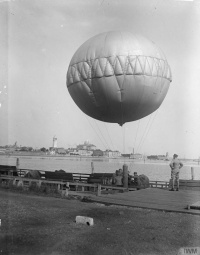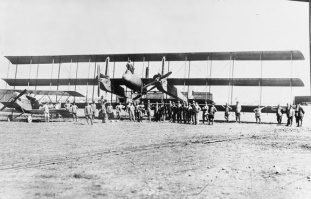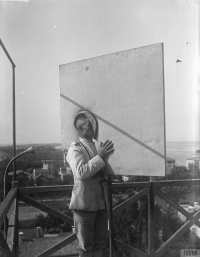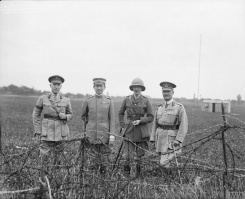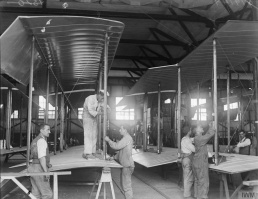Introduction↑
Although, from an organizational and technological point of view, both the research and industrial spheres proved to be unprepared for the immense and unexpected challenges posed by the war, the First World War was an important watershed for the history of Italian science. On the one hand, the processes which had begun in the early post-Risorgimento years came to fruition: a national scientific sector slowly branched out and took its first steps. On the other hand, the war imposed experimental and organizational developments which would, in the years following the conflict, have a long and deep maturation. The establishment of the National Research Council (1923/1929), still operating today, is only the best known example of such a development foreshadowed by the events of the war.
The kingdom of Italy entered the First World War on 24 May 1915, about a year after the outbreak of the conflict between the Central Powers and the nations of the Entente (July/August 1914). The months of neutrality did not witness – except to a very limited extent – an in-depth study of the military and organizational experiences faced by the other belligerents. Reflecting the doubts of national policy, the Italian Society for the Advancement of the Sciences (Società Italiana per il Progresso delle Scienze, or SIPS) and the Accademia Nazionale dei Lincei – the institutional leaders of the scientific world – adopted a public position of prudent caution in July 1914, avoiding openly taking sides.[1] In 1913, the strong point of the Italian scientific world was in the at least 637 scientific-technical university chairs, of which about half were assigned to the medical disciplines and the rest divided virtually equally between physicists, chemists and mathematicians. At the level of university funds, mathematics and medicine received the most lavish contributions, with positive consequences for research funding. There was, however, no room for technological disciplines in the university world. Relegated to a lower level than university courses, with the establishment of "special schools", they were directed less towards the needs of the industrial world, and more towards the requirements of public administration, for which they were a reservoir of staff.[2]
Within the strictly military sphere, the army saw to the scientific training for its technical roles through two institutions: the military school, based in Modena, whose courses were comparable to those of high school students, and the Royal Military Academy, based in Turin, which provided a university-level education.[3] This structure faced the first "war of materials" in history from a position of dual inadequacy: organizational fragmentation as well as technological and financial weakness in research. Despite the limitations in terms of organization and materials, there was an ideological commitment on the part of the scientist-citizens, who, for the most part - although not without agonizing exceptions - took sides after October-November 1914, in favor of entering the war on the side of the Entente. This occurred even though there was, actually, in Italy as throughout Europe, considerable admiration for German science:[4] a fact which, of course, made it very difficult for the scientific world both to take a position, and to continue to hold it. This political position was influenced by a strong tradition of continuity with the patriotic activism of the Risorgimento period, and the traditional view of Austria-Hungary as the enemy par excellence of Italian national unity.
Elderly academics like the mathematician Vito Volterra (1860-1940) and the physicist Giorgio Antonio Garbasso (1871-1933), as well as young assistant professors such as Antonino Lo Surdo (1880-1949) were in the front line in the war effort, as driving forces in the scientific-industrial enterprise, through their practical laboratory work, and, finally, as disseminators, among the general public, of arguments in favor of the Entente. Garbasso, on behalf of the Italian Society of Physics (Società Italiana di Fisica, or SIF), which had gathered for its annual meeting (Pisa, January 1915), was the author of the controversial rejoinder that Italian physicists first put forward to oppose the well-known Manifesto of the 93 signed by the leading German intellectuals in defense of Wilhelmine politics, and then, more specifically, to oppose the German philosopher and chemist Wilhelm Ostwald (1853-1932), the author of a statement issued in Stockholm in October 1914, in which he adhered to the claims of supremacy of "deutsche Kultur"[5]. It should be added that, in terms of propaganda, especially after the serious defeat of Caporetto in October 1917, when the state system was going through a difficult military and political phase, this patriotic commitment reached its peak in an acute paroxysm, testifying to both the irreversible crisis of scientific internationalism, and the choice of Italian scientists not to refrain from the practice of demonizing opposing scholars. There was a series of works belonging to this period, which saw "the serene impartiality" of science fail (Freud), among which those of the neuropsychiatrist Ernesto Lugaro (1870-1940) stand out for their use of the most trivial nationalistic language, only partly masked by the scientific nature of the medical code.
Where, instead, national commitment in favor of the war proved to be timid, this was due to adherence to socialist ideologies or strong admiration for the contacts established with the German cultural world. The latter was the model which, at least since the 1880s, was admired by the Italian sciences. Socialist ideologies were the backcloth of the pacifism of the mathematician Tullio Levi Civita (1873-1941), who corresponded with Albert Einstein (1879-1955) and was the spokesman, in Italy, of the theory of general relativity. Admiration for German culture motivated the points of view of the psychiatrist and neurologist Giovanni Mingazzini (1859-1929) and the mathematician Corrado Segre (1863-1924). Both men supported a neutrality which had ambiguously pro-German overtones. Finally, there were also more complex individual paths: the chemist Ettore Molinari (1867-1926), whose opinion was close to anarchist positions and who was an outspoken critic of Italy's entry into the war, nevertheless accepted a position directing military operations at the SIPE explosives plant at Cengis, and produced excellent results. In fact, under his vigilant direction the production of explosives had increased about forty fold.
In summary, there were two collective attitudes which emerged between 1915 and 1918 in the sphere of the national sciences. In the first place, there was a renewed uncritical faith in scientific utilitarianism, which was seen as science’s ability to resolve problems and therefore, specifically, every type of wartime challenge, as long as it was put in a position to do so, through adequate structures and financing. In the second place, with the passing months, scientific nationalism, fueled by the rejection of “Teutonic” science, almost became a dogma: Italian science could not and should not fear foreign sciences, it should be proud of its own tradition, which, at times rediscovered and at times manipulated, bore witness to its autochthonous greatness. In the field of physics, these feelings of disdain and pride gave rise – just to give one example of the many that there were – to articles published in the official organ of the SIF, “Il nuovo cimento”, by the physicist Gaetano Ivaldi, which aimed at extolling the superiority of Galileo Galilei (1564-1642) and his method compared to the work of the German mathematician Gottfried Wilhelm Leibniz (1646-1716).[6]
Organization↑
The first practical initiatives in organizing research began slowly. They followed a twin track, and were often not coordinated. The mobilization of the scientists’ skills occurred through private individuals who led the nation’s major industrial groups. This period witnessed the creation of the National Committee for the Examination of Inventions Relating to War Materials (Comitato Nazionale di Esame delle Invenzioni attinenti ai Materiali di Guerra, or CNIG), which was set up in July 1915 with the support of the staff of the Politecnico in Milan, the University of Applied Sciences, established in 1863. There was a partial change of pace in the months which marked the transition from the government of Antonio Salandra (1853-1931) to the national unity government led by Paolo Boselli (1838-1932) in July 1916. There were two new factors: on the one hand, there was the implementation of the proposed relationship between industry and university research, on the other hand there was a careful examination of foreign experiences, with the aim of emulating the best practices in France and Great Britain regarding the organization of autonomous state research bodies.[7]
In July 1916, the National Scientific Technical Committee for the Development and Growth of Italian Industry (Comitato nazionale scientifico tecnico per lo sviluppo e l’incremento dell’industria italiana, or CNST) came into being. It took up and developed the preceding work of the CNIG. It had, however, a deeper and more systematic relationship with both the scientific world and that of industrial production. In the front rank of the CNST were the Milanese industrialists, in particular those linked with the electrical energy industry. An indication of the hopes placed in the science/industry union was the fact that in 1916 the CNST organizationally supported the SIP’s ordinary congress[8].
Subsequently, at the urging of figures from the scientific world, like Pietro Giacosa (1853-1928), and the industrial sphere, like Giovanni Battista Pirelli (1848-1932), Angelo Salmoiraghi (1848-1939), Roberto Lepetit (1865-1928) and Emilio Lepetit (1869-1919), committees coordinating the scientific world and industry, organized on different levels, were set up. They were based on the model realized in allied countries, in particular in France. In this meeting between science and industry, the scientists played a prominent and heterogeneous role, in supporting the proposals of the physicist-mathematician Guido Ascoli (1887-1957), which aimed at helping Italian industry to achieve a new development and independence from foreign know how and supplies. This active role was further consolidated in March 1917 when, at the Ministry of War, the Office of Inventions and Research (Ufficio Invenzioni e Ricerche, or UIR) there came into being – the organizational nucleus of the future National Research Council (Consiglio Nazionale delle Ricerche, or CNR).
The UIR was organized into special research services in chemistry, physics, mineralogy and engineering, and subdivided into commissions concerned with analyzing particular problems including increasing the efficiency of the artillery's aim and the wartime use of pyrite ash. The best-known Italian scientists were on the list of the collaborators and consultants of the Office of Inventions and Research. These included, among others: the Nobel Prize winner Guglielmo Marconi (1874-1937), the physicists Pietro Blaserna (1836-1918) and Orso Maria Corbino (1876-1937), the engineer Gustavo Colonnetti (1886-1968) - a future president of the National Research Council - the mineralogist Federico Millosevich (1875-1942), the astronomer Giorgio Abetti (1882-1982), and the geologist Paolo Vinassa de Regny (1871-1957).[9]
Activities and Research↑
Unlike the Second World War, and despite its being a watershed in the history of society and national science, the First World War, at the level of pure research, did not produce fundamental scientific discoveries. Instead, it promoted technical improvements in what was already known in the scientific laboratories. This was also the contemporary opinion of the mathematician Vito Volterra, a prominent figure in the mobilization of Italian scientists, who would depict the conflict as a parenthesis in the ordinary evolution of pure research.[10] In this sense, the Great War cannot be defined a technological conflict, but rather a deadly clash fought out by complex modern states based on the systematic innovation of scientific knowledge acquired before 1914.
In the context of the "war of materials", the chosen field of action of science could only be its technological application. In fact, that was where, amid hesitations, delays and difficulties of various kinds, the scientists’ skills came to be tangibly employed, while the traditional hierarchies between pure and applied science were deeply modified. Moreover, the sudden disappearance for Italy, then in the Entente, of an industrial supplier of products and technology such as Germany, highlighted the urgent need to identify and develop viable alternative sources.
The armed forces offered the most famous scientists of the kingdom the opportunity of serving voluntarily as officers. And so, chemists, physicists, mathematicians and medical researchers were incorporated in military units, in particular in the artillery and engineer corps (as well as the medical units). Through this incorporation, which involved the transfer of highly professional units from civil to military structures, the technical-scientific sector was formed and then consolidated, and directed at contributing directly to the war effort. Through the strictly experimental laboratory activities, the military applications of science cover a wide repertoire of areas and concrete achievements.
It was the task of the mathematicians to make the necessary calculations to prepare the new ballistic tables for the artillery, compelled, for the strategic conditions that characterized the Italian entry into the war, to fire regularly from the bottom upwards, namely from the plain, against the overhead mountain positions manned by the Austro-Hungarian troops. The new ballistic tables had to deal with the problem of the varying air resistance at the different heights through which the projectile had to pass in its trajectory. Of essential importance, in this context, was the work of the mathematician Mauro Picone (1885-1977), on the front in the Venetian Pre-Alps between 1916 and 1917.[11]
As regards the physicists, Antonino Garbasso made in-depth studies of phonotelemetry, with the aim of developing instruments able to locate enemy cannons based on the sound of the initial shot, while Orso Maria Corbino conducted research on the composition of explosives. The Nobel Prize winner Guglielmo Marconi focused his efforts on the study of the nascent broadcasting receivers, working on a radio guidance system for airplanes.
Issues of aerodynamics were dealt with under the supervision of Volterra and Gaetano Arturo Crocco (1877-1968) by the laboratory of the Central Aeronautical Institute (Istituto Centrale Aeronautico, or ICA), where one of the first wind tunnels was constructed. The goal was to achieve better aircraft stability, by eliminating the vibrations due to air resistance. At the same time, new specific weapons for the fledgling flight units of the army were being studied. A laboratory of optics and precision engineering was set up in Florence, after the war had already begun, with the aim of providing the pitched and naval artillery with the necessary means for pointing and remote sensing. The laboratory came to the bitter realization that the previous suppliers of these systems, for Italy, were on the opposing front, and that the country even lacked the basic technical and scientific skills necessary to initiate emergency production. The laboratory went through a difficult period and the project was only partially realized, which the events of Caporetto made even more precarious. The laboratory of precision mechanics, established in Rome under the direct management of the Royal Army, was similar to the Florentine initiative - among other things in its evolution with uncertain outcomes.[12]
The contribution of chemical research, which took advantage of the pre-war studies of figures of international standing such as Stanislao Cannizzaro (1826-1910) and his assistant Giacomo Ciamician (1857-1922), focused on the development of new explosive compounds. At the forefront was the Institute of Chemistry attached to the University of Naples, with its pioneering studies on the development of chloropicrin shells, a highly suffocating tear-gas. The establishment of the air force had a counterpart in the improvement of maritime vessels and submarines and the development of new weapons, especially underwater ones. Mention should be made of Antonino Lo Surdo’s research about underwater listening, the construction and use of C Tubes and the study of Langevin waves. The C Tubes (from the English term “chaser”) indicated devices, more precisely hydrophones, designed to hunt submarines, while Langevin waves (named after the French physicist Paul Langevin) were a technique for the continuous production and reception of ultrasound, suitable for revealing the presence of submarines and conducting marine soundings. While, at the end of the war, Lo Surdo was promoted to lieutenant commander for his wartime achievements, his research was covered by strict secrecy until the early 1920s.[13]
In the field of the mass-production of technical applications, the mechanical, electrical and mining industries showed the greatest synergy with the scientific world. The engineering industry (especially of cars, airplanes, and engines) had an amazing expansion. Macchi, Agnelli Caproni, Isotta Fraschini, Bugatti, Savoia-Verduzio (Ansaldo), Olivetti, Marelli, Breda, Tosi, and Romeo are the names of industries that were born or went through their greatest development and improvement in quality, because of the competition induced by wartime demand.
As regards the aviation industry, whose pioneering phase in Italy can be said to have ended in the early 1910s, it was in fact the war requirements and the orders of the Undersecretariat (later the Ministry) for Weapons and Munitions which decreed its extraordinary expansion. The same wartime pressures also brought into being industries like the Società Veneziana Automobili Navali (SVAN, 1917), from whose shipyards and workshops, gradually technologically improved, there would emerge new weapons like the famous offshore armed motorboats (MAS).[14]
Remarkable results were also achieved by the electrical industry, which aimed at increasing production to make up for, on the one hand, the lack of German coal imports, and, on the other hand, the supply shortage of oil because of the maritime blockades and counter-blockades. The mining industry pursued the objective of a vital increase in production, despite factors such as the mobilization of a large part of the workforce, the decrease in international investment - fundamental in some areas - and the simultaneously increased demand for raw materials for industry, which subjected this sector to a significant stress. The the scientific-technological support for the mining industry was based on the search for new deposits of metals, sulfur and hydrocarbons, the search for new technologies and processes that would ensure a better yield or the further exploitation of deposits considered virtually exhausted, and the reactivation of old, good quality iron mines mainly located in Valle d'Aosta and Tuscany. The extraction of coal, however, slowed down during and after the war, while the search for hydrocarbons intensified in the 1930s and even more in the 1940s and 1950s. Instead, the expansion of the steel industry was expanded by the extraction of metals, the increased demand due to the war effort, and the support and control offered by the state with the Undersecretariat (later the Ministry) for Weapons and Munitions. Although, until the war, the Società degli Altiforni, Acciaierie e Fonderie of Terni had a monopoly on supplying the state, the war itself imposed the termination of this monopoly and sanctioned, at the same time, the success of the two new giants of the national steel industry, Ilva and Ansaldo, which recorded incredible increases in turnover and a major expansion.[15]
The chemical industry witnessed the emergence of the future giant Montecatini - previously engaged in the exploitation of deposits - while some technical advances led to the development of the rubber (Pirelli) and pharmaceutical sectors.[16] The pharmaceutical industry leads us to consider the field of medical research, which deserves a separate discussion. Overall, Italian medicine was called upon to deal with a dual task: to continue pure research in the difficult context of the war; and to provide and maintain an adequate standard in helping those in need of medical attention. A dual task that also involved the health service of the armed forces, which, not coincidentally, increased, in this period, their systematic cooperation with civilian research institutes.
The contribution of the science of war (mainly by physicists and chemists) to medicine promoted important innovations in surgery as well as in field and hospital clinical-health practices. Mountain medicine defined new protocols regarding the merits of the first aid and treatment of frostbite. Emergency medicine, instead, developed a standardization of intervention - assessed on the basis of the progressive gravity of the patients - which would be taken up at the end of the war by civil health facilities. Surgery, called upon to deal with the effects of the explosive-disruptive new weapons, had to come to terms with interventions (for example, amputations) that could not be separated from combating infection. Sepsis and antisepsis became quite common, not without arousing discussions about medical procedures, while the construction of artificial limbs tested the mechanical knowledge of engineers, doctors and craftsmen, who were called upon to participate in an original collaboration.[17]
Chemical research, of fundamental importance for the study of bacteriology and virology, led to improvements in biochemistry and pharmacopoeia (new smallpox, cholera, typhoid and tetanus vaccines; the discovery of bismuth iodide for treating amoebic dysentery). The physical study of X-rays and their implementation through new machines made skeletal radiography common practice. The knowledge of aviation medicine was advanced - especially in terms of cardiac and pulmonary functions - which, in addition to better delineating the physiological reactions to flight, finally permitted the production of liquid oxygen as an anesthetic.[18]
Conclusion↑
The war was a turning point both for the history of Italy and for the history of national science. The ambivalent impact of technology on the conditions of life and death of soldiers and civilians and the cultural influences arising from the conflict (even in the long term) should not, however, be confused. Although it was modern in technological terms because of the way it was waged, the war was not always modern in the cultural and generically behavioral feedback which it activated (as Jay Winter has written in general).
In the short term, the appraisal of three and a half years of wartime research was not exciting. Despite the dedication of the men involved, the activity took place with significant organizational delays, often with inadequate means, through limited exchanges with the sciences of the Allied Powers, and without the close coordination between industry and laboratory that would have avoided the dispersion of initiatives and would have led to the identification of a priority among the objectives to be pursued. In view of a total war that involved and mobilized every national sector, a heavy limit was the small scale of the financial and human resources directly engaged in supporting research. In the long term, however, the assessment presents more detailed aspects.[19] In the 1920s and in the wake of the events of war, the link between industry and the universities was also consolidated in Italy, and there was a strong appreciation of the applied sciences, no longer the Cinderellas of pure research. Moreover, although it is true that the Office of Inventions and Research (UIR) was forced to operate without the necessary funding and lacking organic links to the most modern industrial environment, it offered, thanks to the dedication of its director Vito Volterra and the research associates, a tangible research prototype, coordinated between heterogeneous sectors that had previously often not communicated, and transformed itself in the post-war period into the National Research Council (CNR). The latter, not by chance, was created drawing inspiration from the American institution of the same name, the National Research Council, which had distinguished itself in constituting an important launching pad and support for pure research, in contributing to the war effort, and in representing a model for the development of research in other countries at the national and international level. Volterra, strongly influenced by his international experience arising from the various exchanges and conferences, including meetings related to the creation of the International Research Council, asked for and obtained the recognition of the scope and the results achieved by the Office of Inventions and Research, and worked from the outset of the immediate post-war period for the expansion and structuring of this institution until the emergence of the Council itself in 1923. Overall, it was the tragic experience between 1915 and 1918 which aroused, in Italy, among scientists, politicians and captains of industry, a new sensitivity about scientific research policy and renewed awareness about the need to promote and technically enhance industrial production.[20]
Finally, the events of war significantly redefined the professional and public figure of the scientist, and the perception and impact of the role of science in the context of national life. After November 1918, the approach to science and technology, until then largely inspired by 19th century positivism’s ingenuous scientism or the anti-scientific prejudice of the idealism of figures such as Benedetto Croce (1866-1952) and Giovanni Gentile (1875-1944) – dominant in the Italian cultural debate in the early decades of the 1900s - was called into question. The important role of the scientific-technological mobilization, both during the conflict and in the socio-economic transformations, left its mark, and therefore these areas were revalued, even if this remained largely true for their practical range and their value as indispensable knowledge for the exercise of trades and related professions. On the cultural level, however, it would be precisely the influences of neo-idealism and especially the work of Giovanni Gentile himself as minister of education under fascism, to perpetuate in Italian society the idea of the primacy of the humanities and philosophy over the mathematical, physical and natural sciences and technology.
Andrea Scartabellati, NCTM Law Firm (Library)
Felicita Ratti, Istituto Storico Modena
Section Editor: Nicola Labanca
Translator: Noor Giovanni Mazhar
Notes
- ↑ Tomassini, Luigi: Guerra, scienza, tecnologia, in Storia d’Italia, Annali 26, Scienza e cultura dell’Italia unita, Turin 2011, p. 113.
- ↑ Maiocchi, Roberto: Gli scienziati del Duce. Il ruolo dei ricercatori e del CNR nella politica autarchica del fascismo, Rome 2003, p. 15-16.
- ↑ Balestra, Gian Luca: La formazione degli ufficiali nell´Accademia Militare di Modena (1895-1939), Rome 2000, pp. X-XI and p. 2.
- ↑ Maiocchi, Gli scienziati del Duce 2003, pp. 17-20.
- ↑ Tomassini, Guerra, scienza, tecnologia 2011, p. 107.
- ↑ Renzetti, Roberto: Scienza, tecnica, scuola e sviluppo industriale in Italia dall’Unità alla vigilia della Seconda Guerra Mondiale, issued by Fisica/Mente. Rivista di fisica, didattica della fisica, storia della fisica, fisica e filosofia, problemi della scuola, ambiente, fede e ragione, varia umanità, online: [1] (retrieved 7 April 2014)
- ↑ Tomassini, Guerra, scienza, tecnologia 2011, pp. 113-114.
- ↑ Tomassini, Guerra, scienza, tecnologia 2011, pp. 115-116.
- ↑ Tomassini, Guerra, scienza, tecnologia 2011, pp. 117-119.
- ↑ Tomassini, Guerra, scienza, tecnologia 2011, p. 104.
- ↑ Tanzi Cattabianchi, Luigi: I contributi di Mauro Picone alla balistica razionale, in Rivista di Matematica della Università di Parma 3 (1977), pp. 357-389.
- ↑ Nastasi, Pietro: Matematica e matematici. Dall’Unità, alla metà del Novecento, cap. III par. II: La “grande guerra” e le sue conseguenze, issued by Accademia Nazionale delle Scienze detta dei XL, online [2] (retrieved 7 April 2014).
- ↑ Foresta Martin, Franco / Calcara, Geppi: Per una storia della geofisica italiana. La nascita dell'Istituto Nazionale di Geofisica (1936) e la figura di Antonino Lo Surdo, Milan 2010, pp. 87-93.
- ↑ Cf. Rastelli, Achille / Massignani, Alessandro: La guerra navale 1914-1918. Un contributo internazionale alle operazioni in Mediterraneo, Vicenza 2002.
- ↑ Cf. Bonelli, Franco: Lo sviluppo di una grande impresa in Italia: la Terni dal 1884 al 1962, Turin 1975; Castronovo, Valerio (eds.): Storia dell’Ansaldo, Rome 1994; Cerruti, Luigi: La chimica tra scienza e tecnologia. Il contributo italiano alla storia del pensiero, issued by Enciclopedia Treccani, online [3] (retrieved 7 April 2014).
- ↑ Cerruti, La chimica tra scienza e tecnologia, online.
- ↑ Cf. De Napoli, Domenico: La sanità militare in Italia durante la Prima guerra mondiale, Roma 1989, and Montella, Fabio: Chirurgia e Chirurghi nella Prima guerra mondiale, in Montella, Fabio / Paolella, Francesco / Ratti, Felicita (eds.): Una regione ospedale. Medicina e sanità in Emilia Romagna durante la Prima Guerra Mondiale, Bologna 2010, pp. 111-146.
- ↑ Cf. De Napoli, Domenico: La sanità militare in Italia; Cosmacini, Giorgio: Storia della medicina e della sanità in Italia. Dalla peste nera ai giorni nostri, Roma-Bari 2005; Tognotti, Eugenia: La “spagnola” in Italia. Storia dell’influenza che fece temere la fine del mondo (1918-19), Milano, 2002; Ratti, Felicita: «Qui sono diventati ˈspagnoli’ in molti». Storia sociale comparata della pandemia influenzale 1918-1919 nella provincia di Modena e nel Land Salisburgo, in Montella / Paolella / Ratti: Una regione ospedale, pp.147-232.
- ↑ Maiocchi, Gli scienziati del Duce 2003, pp. 12-20.
- ↑ Guerraggio, Angelo / Paoloni, Giovanni: Vito Volterra, Berlin 2010, pp.113-141.
Selected Bibliography
- Balestra, Gian Luca: La formazione degli ufficiali nell'Accademia militare di Modena, 1895-1939, Rome 2000: Stato maggiore dell'esercito, Ufficio storico.
- Borruso, Edoardo: Studi di storia dell'industria 'milanese' (1836-1983), Milan 1996: Guerini scientifica.
- Cavallo, G. / Messina, A.: Caratteri, ambienti e sviluppo dell’indagine fisica: Storia d’Italia Einaudi, Annali 3, Scienza e tecnica nella cultura e nella società dal Rinascimento a oggi, Turin 1980: G. Einaudi.
- Ciardi, Marco: Breve storia delle teorie della materia, Rome 2003: Carocci.
- Corbino, Epicarmo / Rasi, Gaetano (eds.): La grande guerra e le occasioni perdute (= Annali dell’economia italiana, 1915-1922), volume 6, Milan 1981: Istituto Ipsoa.
- De Napoli, Domenico: La sanità militare in Italia durante la prima guerra mondiale, Rome 1989: Apes.
- Dragoni, Giorgio: Per una storia della fisica italiana tra la seconda metà dell’Ottocento e la Prima guerra mondiale, in: Maccagni, Carlo / Freguglia, Paolo (eds.): Storia sociale e culturale d’Italia. La cultura filosofica e scientifica. La storia delle scienze, volume 2, Busto Arsizio 1989: Bramante Editrice, pp. 826-871.
- Foresta Martin, F. / Calcara, Geppi: Per una storia della geofisica italiana la nascita dell'Istituto Nazionale di Geofisica (1936) e la figura di Antonino Lo Surdo, Milan 2010: Springer.
- Freud, Sigmund: Considerazioni attuali sulla Guerra e la morte (1915): Opere, Rome 2006: Gruppo editoriale L'Espresso.
- Gentile, Giovanni / Tumminelli, Calogero (eds.): Enciclopedia italiana di scienze, lettere ed arti, Rome 1929-1939: Istituto Giovanni Treccani.
- Goodstein, Judith R.: The Volterra chronicles. The life and times of an extraordinary mathematician, 1860-1940, Providence 2007: American Mathematical Society; London Mathematical Society.
- Guerraggio, Angelo / Nastasi, Pietro: L'Italia degli scienziati. 150 anni di storia nazionale, Milan 2010: B. Mondadori.
- Israel, Giorgio / Nastasi, Pietro: Scienza e razza nell'Italia fascista, Bologna 1999: Il Mulino.
- Istituto della Enciclopedia italiana (ed.): Dizionario biografico degli Italiani, Rome 1960: Istituto della Enciclopedia Italiana.
- Lugaro, Ernesto: La psichiatria tedesca nella storia e nell'attualità, Florence 1916: Tip. Galileiana.
- Maiocchi, Roberto: Gli scienziati del Duce. Il ruolo dei ricercatori e del CNR nella politica autarchica del fascismo, Studi storici Carocci, 9, Rome 2003: Carocci.
- Maiocchi, Roberto: Scienza italiana e razzismo fascista, Scandicci 1999: La nuova Italia.
- Mondella, F. / Carugo, A: Lo sviluppo delle scienze e delle tecniche in Italia dalla metà del XIX secolo alla Prima guerra mondiale: Nuove questioni di storia del Risorgimento e dell'unità d'Italia, Milan 1976: Marzorati.
- Morselli, Enrico: Il dovere dei medici nell’ora presente, Milan 1917.
- Pizzorni, Geoffrey John (ed.): L'industria chimica italiana nel Novecento, Milan 2006: F. Angeli.
- Simili, Raffaella / Paoloni, Giovanni: Per una storia del Consiglio nazionale delle ricerche, Rome 2001: Laterza.
- Tanzi Cattabianchi, Luigi: I contributi di Mauro Picone alla balistica razionale, in: Rivista Matematica dell’Università di Parma 3, 1977, pp. 357-389.
- Tomassini, Luigi: Guerra, scienza, tecnologia: Storia d’Italia. Scienza e cultura dell’Italia unita, volume 26, Turin 2011: Einaudi, pp. 103-128.
- Volterra, Vito / Paoloni, Giovanni: Vito Volterra e il suo tempo (1860-1940). Mostra storico-documentaria, Rome 1990: Accademia nazionale dei Lincei.
- Winter, Jay: Il lutto e la memoria. La grande guerra nella storia culturale europea, Bologna 1998: Il Mulino.





